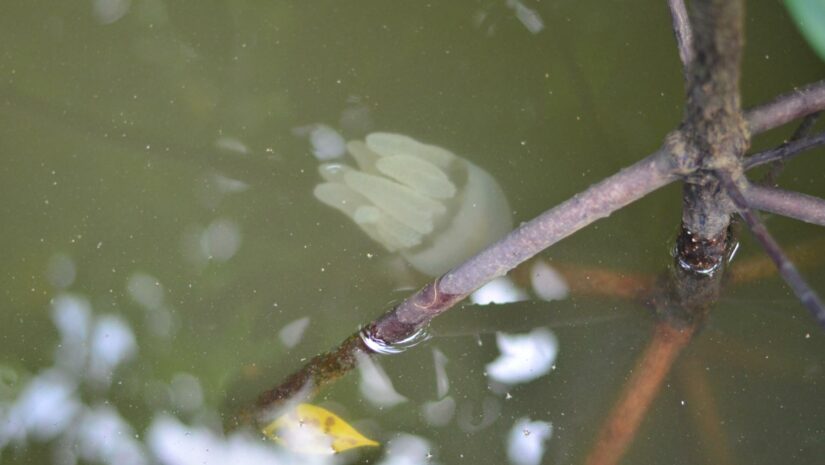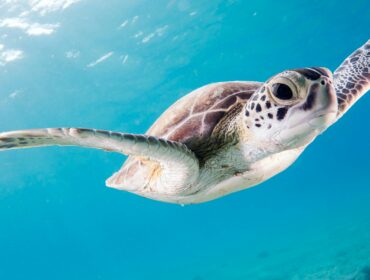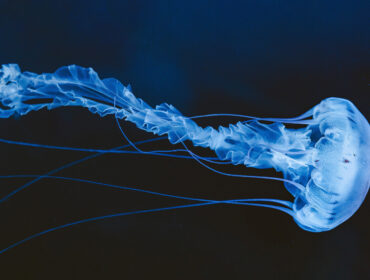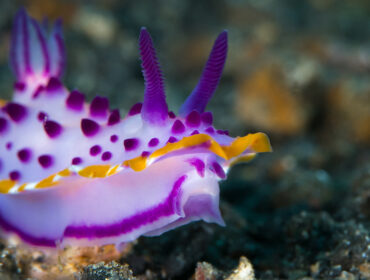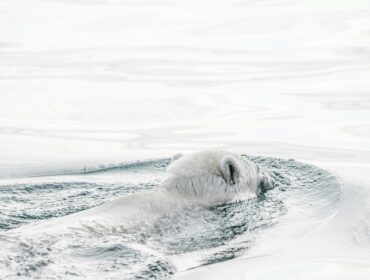Brackish water, the unique mix of freshwater and seawater found in estuaries, mangroves, and river mouths, harbors a diverse array of fascinating fish species. These environments serve as crucial habitats, supporting coastal biodiversity and acting as nursery grounds for marine life. In this article, we delve into the world of brackish water fish, exploring their adaptations, ecological importance, and the challenges they face. Additionally, we’ll discuss the allure of keeping brackish water fish in home aquariums and their significance in aquaculture and fisheries.
What is brackish water?
Brackish water lies at the crossroads between freshwater and marine ecosystems. The varying salinity levels in these habitats provide a unique challenge for aquatic life to adapt and thrive. Estuaries, where rivers meet the sea, and mangroves, dense coastal forests of salt-tolerant trees, are prime examples of brackish water habitats. These environments are distributed globally, from the Amazon River delta to the Sundarbans in Bangladesh.
Containing 0.5 to 30 grams of salt per liter, brackish, or briny water is saltier than freshwater and less salty than ocean water. While this ecosystem can be hostile for many aquatic species, it hosts more creatures than one might initially think. If you’ve always wondered which animals dwell in briny water, here are five extraordinary brackish water species that call these environments home.
Brackish Water Fish Species
The diverse and vibrant fish species found in brackish water ecosystems have evolved specialized adaptations to endure fluctuating salinity levels.
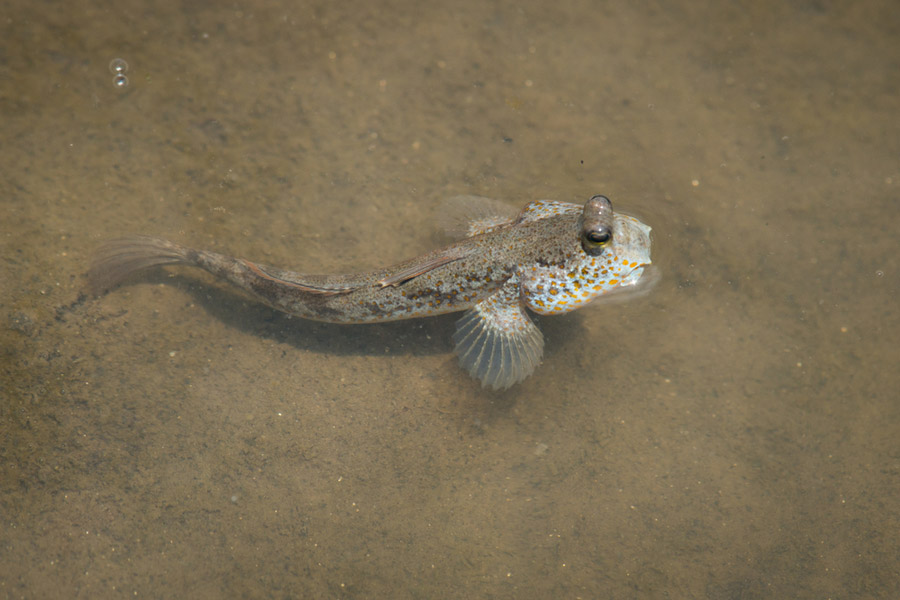
- Crab-Eating Frog
- Archer Fish
- Dragon Goby
- Mudskipper
- American Alligator
- Serrated Swimming Crab
- Bumblebee Goby
- Orange Chromide
Crab-Eating Frog

You can spot the crab-eating frog (Fejervarya cancrivora) in Taiwan, China, the Philippines, and other Southeast Asian countries. It can also be spotted in Orissa, India. Crab-eating frogs can live in different lowland habitats, but they also reside in coastal scrub, marshes, mangroves, and coastal rice paddies.
These amphibians have discontinuous skin folds or ridges across their backs and relatively big eyes. Light and dark mottling, as well as pale and dark brown blotches, often make up the crab-eating frog’s color and pattern. But their colors and patterns may vary slightly. Some specimens even have vertebral stripes on their bodies.
True to their name, crab-eating frogs consume crabs when they’re in mangrove swamps. They also eat small crustaceans and insects that reside in freshwater. Crab-eating frogs can tolerate both brackish water and seawater, making them the only amphibians with this unique trait. To survive in these environments, they produce high amounts of urea. This ability lets them control their skin’s osmolar concentration.
Archer Fish
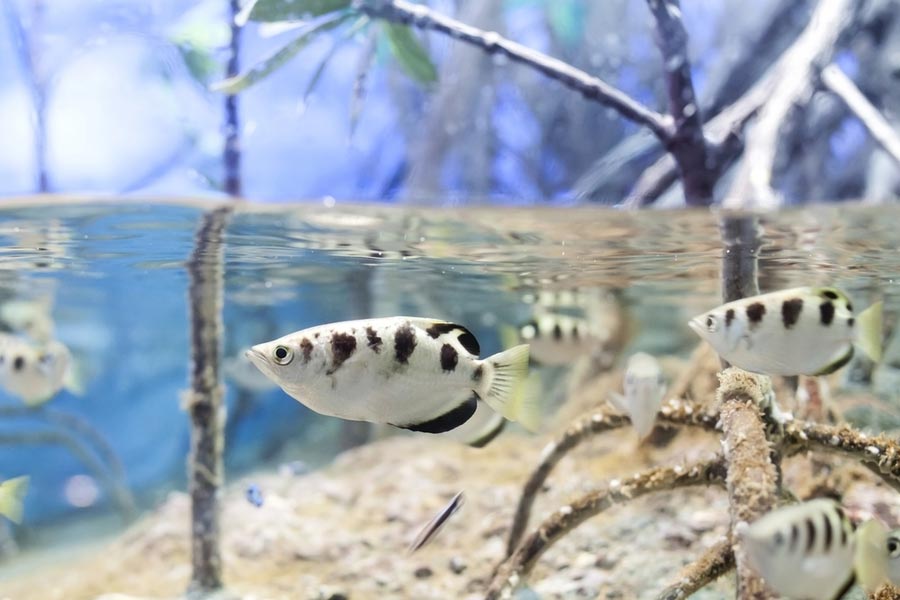
With the unique ability to shoot down its prey, the archer fish turns tiny animals and insects into tasty snacks. It hunts by spitting water at insects, which knocks them off hanging plants. Once the fish takes its prey down, it catches them when they fall into the water. Archer fish can spit water up to five feet since their mouths work like a gun barrel.
These brackish water fishes have an elongated form and fairly deep bodies. Their bodies are nearly flat from the dorsal fin forward with a pointed head and a big mouth. Archer fish also feature dorsal and anal fins towards their backs. They may even have spotted or vertically banded patterns in black.
Archer fish mostly live in mangroves and estuaries, but they also reside in upstream freshwater and open oceans. You can spot these brackish fishes in Australia, India, Polynesia, and the Philippines.
Dragon Goby
The dragon goby (Gobioides broussonnetii) has a long, slender body and a silvery gold iridescence to its skin. It comes in a bright purple color, which explains why people sometimes call the species “violet goby.” Dragon gobies look like eels but they’re not actual eels. They can also reach up to two feet in length.
Dragon fish feature large mouths with a trap door shape and easily visible teeth. These brackish water animals have sharp teeth just like their namesake. But unlike other fish species, dragon gobies are scavengers, not hunters. They scrape marine algae off rocks in their environment with their teeth instead of using them to fight other fish. You’ll also see dragon gobies scooping up mouthfuls of substrate, sifting it for anything edible.
Violet gobies call the swamp waters around Florida and the Gulf of Mexico their home. They like dwelling in waters with muddy bottoms. Dragon gobies also hide in the sand, behind rocks, and under plants in brackish ecosystems, proving that they’re calm creatures.
Mudskipper
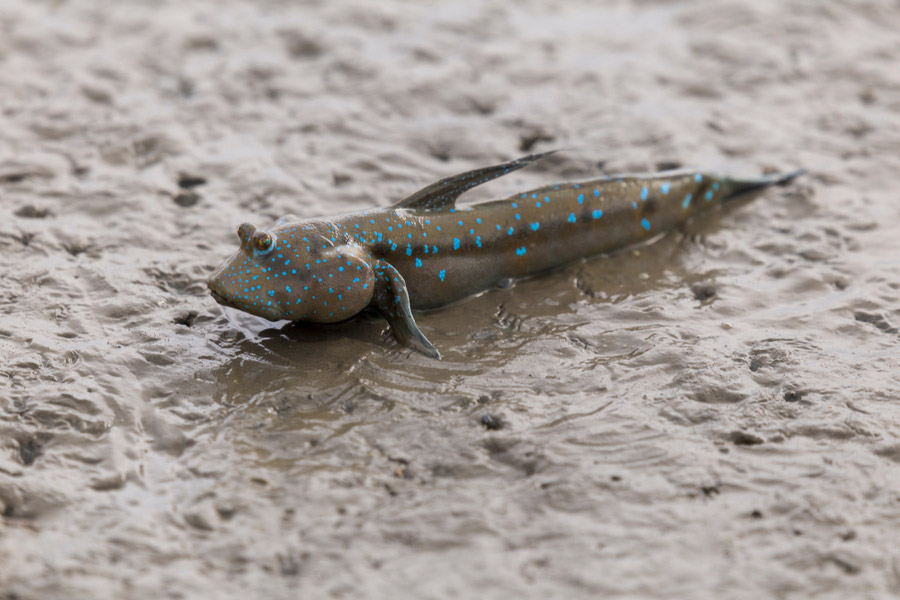
Comprising around six small tropical goby species in the Gobiidae family, the mudskipper partially lives on land. It crawls out of the water and walks around to hunt for food using its pectoral fins. Mudskippers can breathe air from their gill chambers and through their skin, which helps them live as amphibians.
This brackish fish is elongated and can grow to around 30 centimeters (12 inches). It has two dorsal fins, as well as forward-facing pelvic fins under its body. Mudskippers can have partly or entirely fused pelvic fins. They also boast blunt heads with big, moving, close-set, and protruding eyes.
Most of these brackish water fish species are carnivores with a diet that consists of different organisms. This diet includes insects, worms, and small crustaceans. Mudskippers also occasionally feed on smaller members of their species.
Africa, Asia, Australia, the Philippines, Samoa, and Tonga are places where mudskippers take residence. You’ll often see them in tropical and subtropical habitats, and some species can be found in temperate environments. Mudskippers reside in intertidal zones or swamps and rivers with moving tides. Aside from making brackish water environments their home, they can also survive in various salinities.
American Alligator

Fishes aren’t the only animals that live in brackish waters. The American alligator is one of its largest residents. Males can reach 10 to 15 feet on average, while females can grow up to around 9.8 inches. Males also weigh in at a maximum of 1,000 pounds. But don’t let their big size fool you, as they swim and adapt to their habitats very well.
American alligators are native to the southeastern United States and reside in freshwater rivers, lakes, swamps, and marshes. You’ll see them roaming around these bodies of water, from North Carolina to the Rio Grande in Texas.
Gators, as people like to call this species, are carnivores. Their diet mostly consists of fish, turtles, snakes, and small mammals. They’ll eat just about anything when they get the chance, including carrions, pets, and humans (which they fortunately rarely prey on).
Serrated Swimming Crab
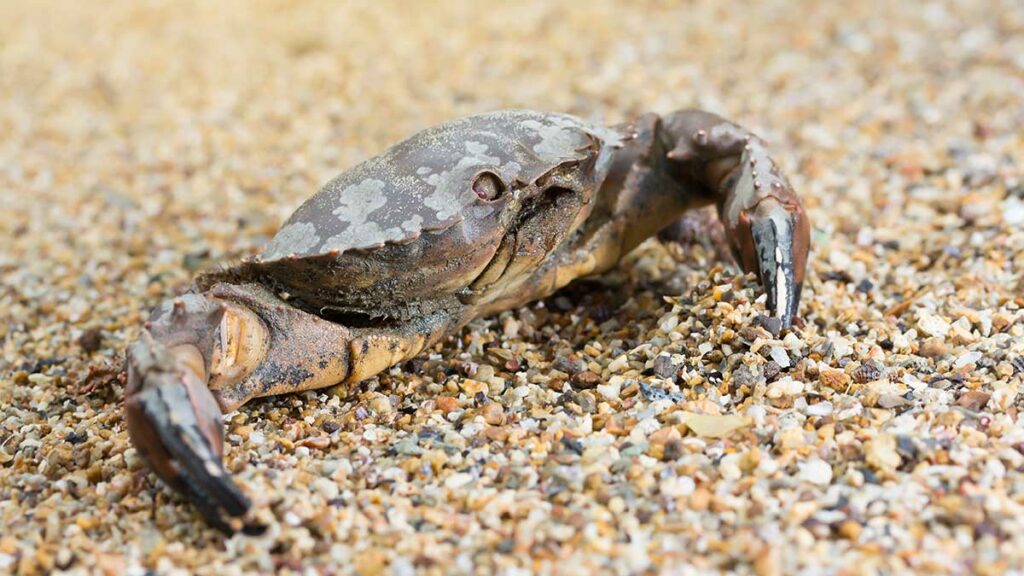
The Serrated Swimming Crab (Charybdis feriatus) is a fascinating crustacean found in the coastal waters of the Indo-Pacific region. Known for its striking appearance, this crab sports a serrated carapace and long, slender legs that aid in its swift swimming capabilities. The coloration of its shell can range from greenish-brown to reddish-brown, providing excellent camouflage among the rocky and sandy substrates it inhabits.
Despite its formidable appearance, the Serrated Swimming Crab primarily feeds on small invertebrates and detritus. As a valuable part of the marine ecosystem, this crab plays a role in maintaining the balance of coastal communities.
Bumblebee Goby
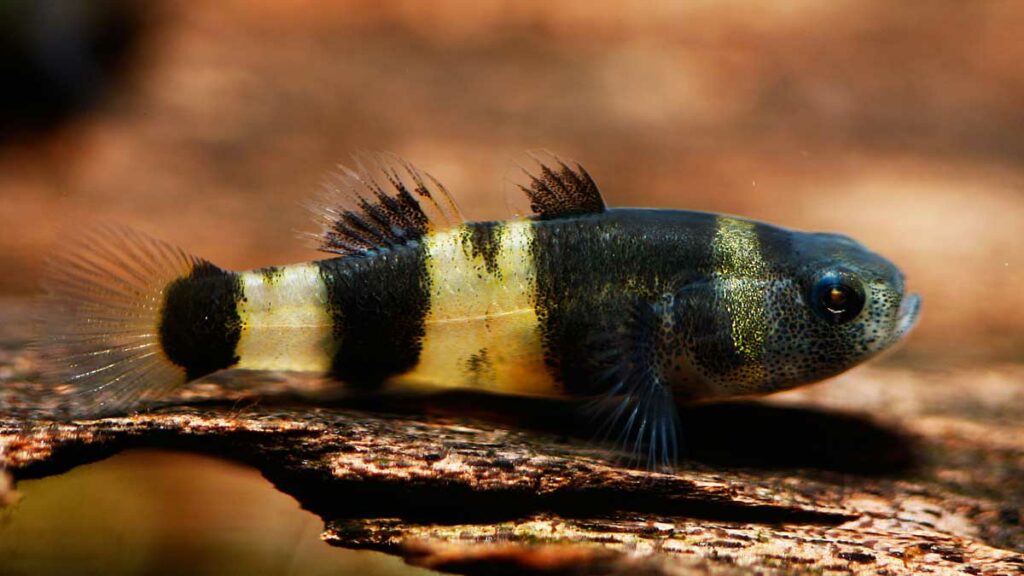
The Bumblebee Goby (Brachygobius xanthozonus) is a charming and petite freshwater fish native to Southeast Asia. Characterized by its bright yellow and black striped pattern, resembling a bumblebee, this goby adds a splash of color to aquariums. With a peaceful demeanor, it coexists well with other non-aggressive fish species. Its small size, reaching around 1.5 inches, makes it an ideal choice for nano aquariums.
The Bumblebee Goby is a bottom-dweller and prefers soft, sandy substrates to explore and burrow in. Providing a well-planted aquarium with hiding spots mimics its natural habitat and ensures its contentment in captivity.
Orange Chromide
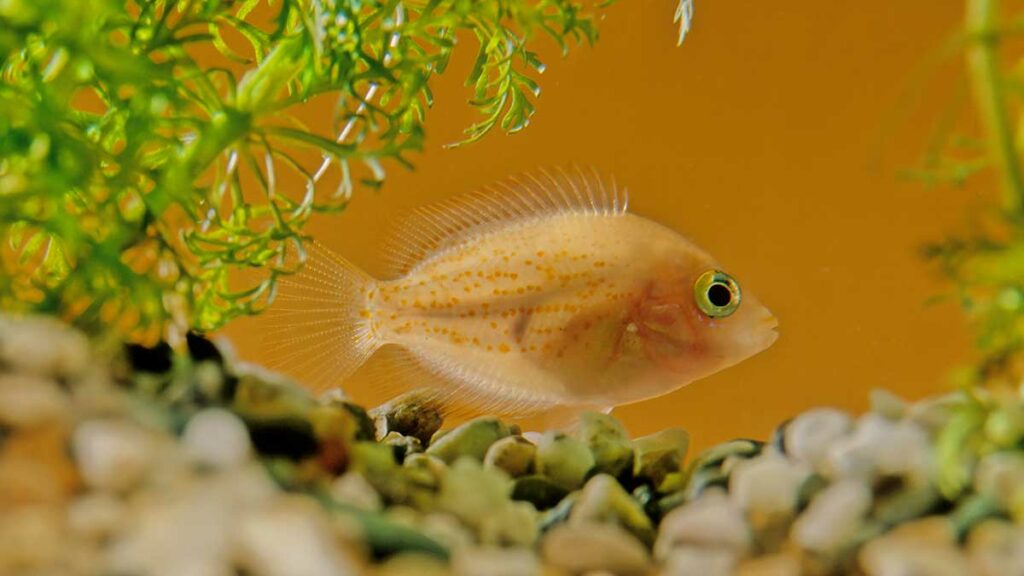
The Orange Chromide (Etroplus maculatus) is a striking freshwater fish native to the brackish and freshwater habitats of South India and Sri Lanka. Renowned for its vibrant orange coloration, this cichlid species possesses a unique and attractive appearance. Growing up to 4 inches in length, they are suitable for moderately-sized aquariums.
The Orange Chromide is a peaceful and social fish, best kept in small groups or pairs. It thrives in well-planted aquariums with hiding spots and open swimming areas. Due to its adaptability to varying water conditions, this species makes an excellent choice for both beginner and experienced aquarists.
The Ecological Importance of Brackish Water Ecosystems
Brackish water habitats play a critical role in coastal ecosystems. Mangroves and estuaries serve as crucial nursery grounds for various marine species, providing them with shelter and abundant food sources during their early stages of life. These habitats act as natural buffers, protecting coastlines from erosion and storm surges. Additionally, they play a vital role in filtering pollutants from the surrounding land, enhancing water quality and supporting a thriving marine community.
Challenges and Threats to Brackish Water Fish
Despite their ecological significance, brackish water habitats and their inhabitants face numerous challenges. Pollution from agricultural runoff and urban development can degrade water quality and impact fish populations. Rising sea levels and climate change pose a threat to mangroves and estuaries, potentially disrupting the delicate balance of these ecosystems. Conservation efforts are vital to preserving these critical habitats and the diverse species that rely on them.
Brackish Water Fishkeeping
Brackish water fishkeeping has gained popularity in the aquarium hobby. Hobbyists can recreate the unique conditions of brackish water environments in their tanks and enjoy the company of captivating fish species. Setting up a brackish water aquarium requires attention to water parameters, suitable filtration systems, and a variety of habitat enrichments. It offers enthusiasts an opportunity to observe the unique behaviors and interactions of these adaptable fish.
Brackish Water Fish in Aquaculture and Fisheries
Brackish water fish have economic significance in aquaculture and commercial fishing industries. Many species are bred in aquaculture settings due to their adaptability and market demand. Sustainable aquaculture practices are essential to minimize environmental impacts and maintain the delicate balance of brackish water ecosystems. Responsible management of brackish water fish populations is crucial to ensure their long-term viability.
Conservation Initiatives and Research
Conservation efforts and research play a pivotal role in understanding and protecting brackish water ecosystems. Local communities, environmental organizations, and governments collaborate to safeguard these unique habitats. Ongoing research efforts provide valuable insights into the intricacies of brackish water ecosystems, helping inform conservation strategies and sustainable management practices.
The Beauty of Brackish Water Fish
Brackish water fish captivate with their diversity, striking colors, and extraordinary adaptations. Diving into these enchanting environments or keeping brackish water fish in aquariums allows us to witness the delicate balance of life in these habitats. Let us appreciate and protect the wonders of brackish water ecosystems to ensure these incredible fish species continue to thrive in their natural homes.
Conclusion
The world of brackish water fish is one of resilience and balance. As we explore the intricate tapestry of life in these habitats, we become more aware of their ecological importance and the need for their conservation. From the estuaries to the mangroves, these ecosystems remind us of the interconnectedness of the natural world. Let us cherish the beauty of brackish water fish and actively contribute to the preservation of their unique and fragile habitats.

